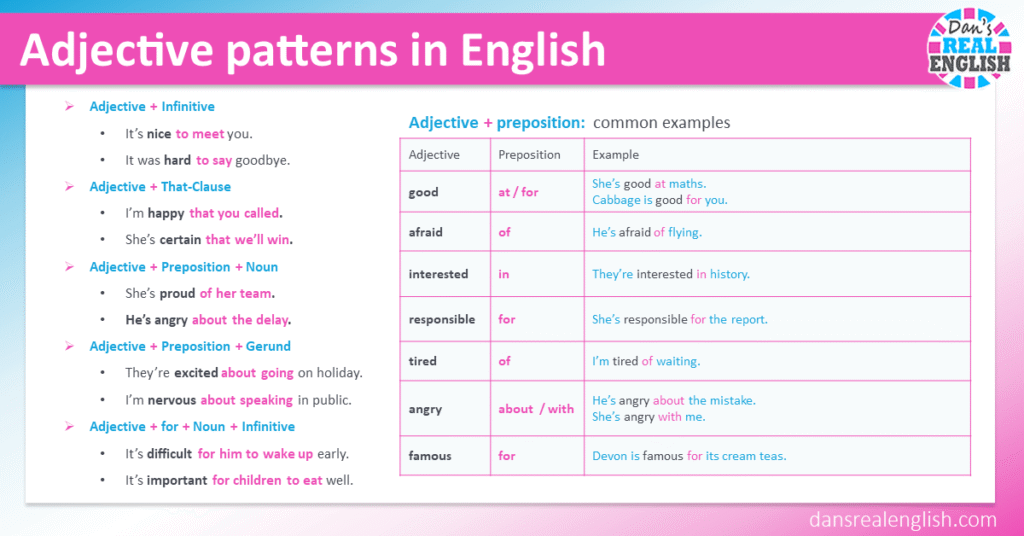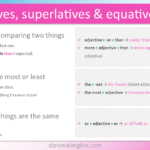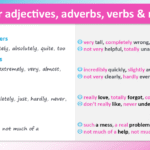Many phrases begin with adjectives in English, but not everyone gets these grammar patterns right.
After all, it’s not always easy to know what kind of word should come after certain adjectives.
For example, which of these phrases do you think is correct?
“It’s easy to drive a car” .. or .. “It’s easy driving a car?” (answer below!)
Learning about adjective patterns is a quick way to improve your accuracy in English.
In this free English grammar lesson, I’ll show you how to use common adjective patterns in English, with examples and exercises.
Contents
Understanding adjective patterns
What are adjective patterns?
Adjective patterns are phrase “shapes” made by adjectives. They help us make correct and natural sentences.
We use adjective patterns to express many different functions, like:
- Show how we feel
- Give opinions
- Say how easy or hard something is
- Talk about duties or beliefs
Examples:
It’s easy to use.
NOT: It’s easy using.
How to make adjective patterns
Here are some of the most common adjective patterns:
- Adjective + infinitive → It’s easy to use
- Adjective + that-clause → I’m sure that it’s true
- Adjective + preposition + noun → She’s good at maths
- Adjective + preposition + gerund → They’re excited about travelling
- Adjective + for + noun + infinitive → It’s important for them to study
Each adjective pattern has its own structure.

Here’s a breakdown of each pattern with clear examples:
Adjective + infinitive
This pattern shows how someone feels about an action or gives an opinion about doing something.
- Structure: adjective + to + base verb
- Example: It’s easy to understand.
| Adjective | Infinitive Example | Full Sentence Example |
|---|---|---|
| easy | to use | The app is easy to use. |
| happy | to help | She’s happy to help. |
| difficult | to explain | It’s difficult to explain. |
| nice | to meet you | It’s nice to meet you. |
| important | to remember | It’s important to remember names. |
Adjective + that-clause
This grammar pattern introduces another action as part of a that-clause:
- Structure: adjective + that + subject + verb
- Example: I’m sure that he knows.
| Adjective | Clause Example | Full Sentence Example |
| sure | that he knows | I’m sure that he knows. |
| glad | that you came | We’re glad that you came. |
| happy | that she passed | I’m happy that she passed. |
| lucky | that we arrived on time | It’s lucky that we arrived on time. |
| aware | that it might rain | He’s aware that it might rain. |
Adjective + preposition + noun
The adjective + preposition + noun pattern links the adjective to a specific noun.
This is used to describe a connection between the adjective and a noun.
- Structure: adjective + preposition + noun
- Example: She’s proud of her school.
| Adjective | Preposition | Noun Example | Full Sentence Example |
| proud | of | her school | She’s proud of her school. |
| famous | for | his paintings | He’s famous for his paintings. |
| good | at | maths | He’s good at maths. |
| interested | in | history | She’s interested in history. |
| responsible | for | the report | He’s responsible for the report. |
Adjective + preposition + gerund
Some adjectives are followed by a preposition and then a verb in -ing form.
- Structure: adjective + preposition + gerund
- Example: They’re interested in learning.
| Adjective | Preposition | Gerund Example | Full Sentence Example |
| tired | of | waiting | We’re tired of waiting. |
| excited | about | going | They’re excited about going. |
| afraid | of | falling | He’s afraid of falling. |
| good | at | cooking | She’s good at cooking. |
| responsible | for | organising | He’s responsible for organising. |
Adjective + for + noun + infinitive
This pattern shows who is affected by or involved in an action described by the adjective.
- Structure: adjective + for + noun + to + base verb
- Example: It’s important for students to learn.
| Adjective | Noun Example | Infinitive Example | Full Sentence Example |
| important | students | to revise | It’s important for students to revise. |
| difficult | him | to explain | It’s difficult for him to explain. |
| easy | us | to understand | It’s easy for us to understand. |
| necessary | workers | to rest | It’s necessary for workers to rest. |
| unusual | her | to be late | It’s unusual for her to be late. |
Using adjective patterns in context
Example monologue
This informational text shows how we use adjective patterns in sentences.
Many students find it difficult to study when their environment is noisy. That’s why it’s useful for learners to create a quiet space. Researchers are also interested in how people manage stress during exams. It’s common for students to feel anxious, but it’s helpful to build routines that lower pressure. Some students are concerned that they won’t perform well, which is why support systems are important. It’s also essential to get enough sleep and take breaks. These strategies are effective in improving both focus and results.
Mistakes to avoid
- Wrong preposition: She’s good in English. → She’s good at English.
- Wrong verb form: He’s interested in hike. → He’s interested in hiking.
Adjective pattern exercises
Exercise 1 – Complete the sentences
(Use the correct form of the verb in brackets.)
- She’s excited about ___________ (travel).
- It’s important for us ___________ (be) on time.
- I’m happy that you ___________ (call).
- He’s responsible for ___________ (organise) the event.
- This book is easy ___________ (understand).
- They were afraid of ___________ (lose) the keys.
- It’s good for children ___________ (have) routines.
- I’m sure that she ___________ (arrive) soon.
Exercise 2 – Correct the mistake
- I’m tired from wait.
- She’s afraid from flying.
- It’s difficult to him to focus.
- We’re sure you’ll come.
- He’s good on football.
- It’s worth to try again.
- She’s responsible of the money.
- I’m happy you visit.
Exercise 3 – Choose the right option
- I’m interested ___ learning Spanish.
a) of b) in c) at - It’s important ___ children to eat well.
a) to b) for c) of - She’s good ___ painting.
a) on b) in c) at - I’m proud ___ my team.
a) of b) for c) with - It’s easy ___ forget things when you’re tired.
a) to b) for c) at - He’s afraid ___ snakes.
a) to b) from c) of - I’m happy ___ you passed.
a) that b) to c) in - This task is hard ___ me to finish.
a) to b) for c) with
Answer key
Exercise 1
- travelling
- to be
- called
- organising
- to understand
- losing
- to have
- arrived
Exercise 2
- I’m tired of waiting.
- She’s afraid of flying.
- It’s difficult for him to focus.
- We’re sure that you’ll come.
- He’s good at football.
- It’s worth trying again.
- She’s responsible for the money.
- I’m happy that you visited.
Exercise 3
- b) in
- b) for
- c) at
- a) of
- a) to
- c) of
- a) that
- b) for







